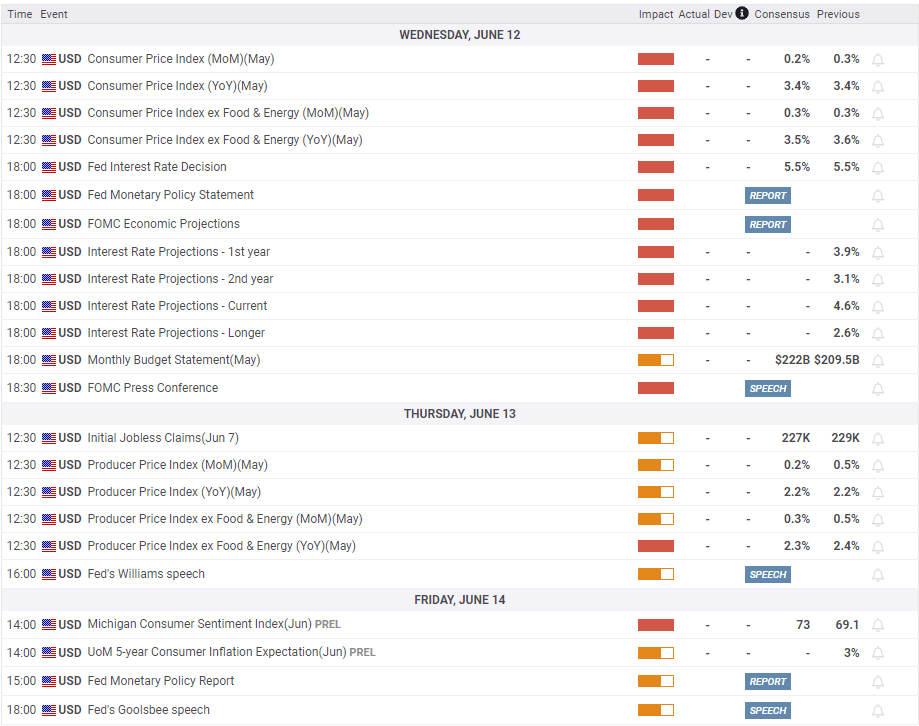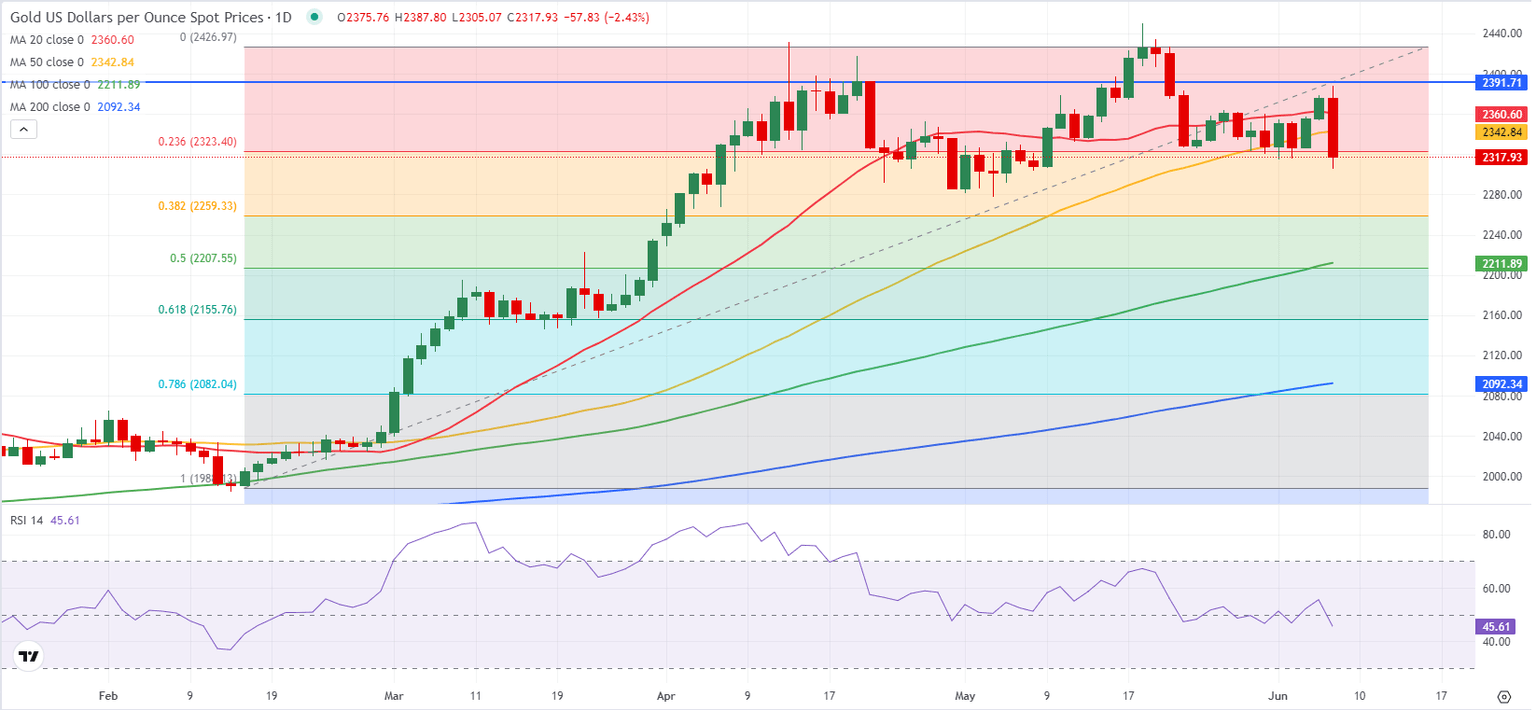Gold Weekly Forecast: Dot plot, US CPI to set direction after hot jobs data dims Fed rate-cut bets
- Gold lost its bullish momentum on Friday, ending the week little changed.
- The Fed’s policy announcements and US inflation data could significantly influence XAU/USD’s action.
- The near-term technical outlook highlights buyers’ hesitancy.

Gold (XAU/USD) started the week on a firm footing, boosted by the sharp decline seen in the US Treasury bond yields, but news of China pausing Gold purchases for the first time in 18 months and upbeat US jobs data limited its upside. May inflation report from the US and the Federal Reserve’s (Fed) monetary policy announcements next week could trigger the next big action in Gold.
Gold buyers hesitate to bet on a decisive rally
The US Dollar (USD) came under selling pressure in the American session on Monday and helped Gold gain traction. The ISM Manufacturing PMI dropped to 48.7 in May from 49.2 in April, showing the contraction in the manufacturing sector's business activity gathered pace. Additionally, the inflation component of the survey, the Prices Paid Index, dropped to 57 from 60.9, highlighting a softer input inflation.
The negative shift seen in risk mood on Tuesday helped the USD stay resilient against its rivals and made it difficult for XAU/USD to build on Monday’s gains. On Wednesday, the ISM Services PMI came in at 53.8 and surpassed the market expectation of 50.8. Although this reading helped the USD find demand with the immediate reaction, the currency’s gains remained limited as the Prices Paid Index edged lower to 58.1 from 59.2 in April. Other data from the US showed that employment in the private sector rose by 152,000, falling short of analysts’ estimate for an increase of 173,000.
After falling nearly 5% in the first half of the week, the benchmark 10-year US Treasury bond yield continued to push lower on Thursday. The US Bureau of Labor Statistics (BLS) announced that Unit Labor Costs rose 4% in the first quarter, down sharply from the 4.7% reported in the initial estimate, and the Department of Labor said that the number of first-time applications for unemployment benefits in the week ending June 1 rose to 229,000 from 221,000 in the previous week. In turn, Gold reached its highest level since late May above $2,380.
On Friday, Reuters reported that the People’s Bank of China (PBoC) halted Gold purchases to its reserves in May after increasing Gold reserves for 18 consecutive months. “China held 72.80 million troy ounces of gold at the end of May, unchanged from the end of April, the data showed,” Reuters said. With the immediate reaction to this headline, XAU/USD dropped below $2,340, erasing a large majority of its weekly gains in the process.
In the American session, the BLS reported that Nonfarm Payrolls rose 272,000 in May. As this figure surpassed the market consensus of 185,000 by a wide margin, US T-bond yields shot higher and Gold came under heavy selling pressure, losing more than 2% on the day.
Gold investors await US inflation data and Fed decisions
Gold could struggle to find direction at the beginning of next week, with investors staying on the sidelines ahead of the highly-anticipated May inflation data and the Fed’s monetary policy meeting.
On Wednesday, the BLS will publish inflation readings. On a monthly basis, the Consumer Price Index (CPI) is forecast to rise 0.2% following the 0.3% increase recorded in April. The core CPI, which excludes volatile food and energy prices, is seen increasing 0.3% to match April’s growth. In case the monthly core CPI rises more than expected in May, the immediate reaction could provide a boost to the USD and trigger a leg lower in Gold. On the other hand, a reading of 0.2% or lower could open the door for an extended slide in US T-bond yields and allow XAU/USD to gather bullish momentum.
The Fed is widely expected to leave its policy rate unchanged on Wednesday. Investors will pay close attention to the revised Summary of Economic Projections (SEP), the so-called dot plot. In March, the dot plot showed that policymakers were forecasting a total of 75 bps reduction in the policy rate in 2024.
According to the CME FedWatch Tool, markets price in a nearly 55% probability that the Fed will reduce the policy rate by 50 bps this year. If the dot plot shows that the majority of policymakers expect only one 25 bps rate cut this year, Gold could decline sharply. On the flip side, the market positioning suggests that there is room for further USD weakness in case the SEP shows that policymakers favor a 50 bps reduction in the policy rate in 2024.
The US economic docket will not offer any high-impact macroeconomic data releases in the second half of the week. With the Fed’s blackout period coming to an end on Thursday, market participants will pay close attention to comments from Fed officials ahead of the weekend.
Economic Indicator
FOMC Economic Projections
At four of its eight scheduled annual meetings, the Federal Reserve (Fed) releases a report detailing its projections for inflation, the unemployment rate and economic growth over the next two years and, more importantly, a breakdown of each Federal Open Market Committee (FOMC) member's individual interest rate forecasts.
Read more.Last release: Wed Mar 20, 2024 18:00
Frequency: Irregular
Actual: -
Consensus: -
Previous: -
Source: Federal Reserve
Gold technical outlook
The Fibonacci 23.6% retracement from the mid-February movement aligns as a pivot level at $2,320. If Gold confirms this level as resistance, $2,300 (psychological level, static level) could be seen as interim support before $2,260 (Fibonacci 38.2% retracement).
On the upside, the 20-day Simple Moving Average aligns as interim resistance at $2,360 before $2,390 (static level) and $2,400 (psychological level, static level).
Meanwhile, the Relative Strength Index (RSI) indicator on the daily chart declined below 50, reflecting a modest buildup in bearish momentum.
Gold FAQs
Gold has played a key role in human’s history as it has been widely used as a store of value and medium of exchange. Currently, apart from its shine and usage for jewelry, the precious metal is widely seen as a safe-haven asset, meaning that it is considered a good investment during turbulent times. Gold is also widely seen as a hedge against inflation and against depreciating currencies as it doesn’t rely on any specific issuer or government.
Central banks are the biggest Gold holders. In their aim to support their currencies in turbulent times, central banks tend to diversify their reserves and buy Gold to improve the perceived strength of the economy and the currency. High Gold reserves can be a source of trust for a country’s solvency. Central banks added 1,136 tonnes of Gold worth around $70 billion to their reserves in 2022, according to data from the World Gold Council. This is the highest yearly purchase since records began. Central banks from emerging economies such as China, India and Turkey are quickly increasing their Gold reserves.
Gold has an inverse correlation with the US Dollar and US Treasuries, which are both major reserve and safe-haven assets. When the Dollar depreciates, Gold tends to rise, enabling investors and central banks to diversify their assets in turbulent times. Gold is also inversely correlated with risk assets. A rally in the stock market tends to weaken Gold price, while sell-offs in riskier markets tend to favor the precious metal.
The price can move due to a wide range of factors. Geopolitical instability or fears of a deep recession can quickly make Gold price escalate due to its safe-haven status. As a yield-less asset, Gold tends to rise with lower interest rates, while higher cost of money usually weighs down on the yellow metal. Still, most moves depend on how the US Dollar (USD) behaves as the asset is priced in dollars (XAU/USD). A strong Dollar tends to keep the price of Gold controlled, whereas a weaker Dollar is likely to push Gold prices up.
Premium
You have reached your limit of 3 free articles for this month.
Start your subscription and get access to all our original articles.
Author

Eren Sengezer
FXStreet
As an economist at heart, Eren Sengezer specializes in the assessment of the short-term and long-term impacts of macroeconomic data, central bank policies and political developments on financial assets.



















